INTRODUCTION
My first trip to Romania took
place in 1994. It was the result of my growing interest in Dracula,
the novel by Bram Stoker, and the historical Dracula, Vlad the Impaler.
The tour that I took that summer was a package offered by Carpati
International in New York. It included the sites associated with Vlad:
Tirgoviste, Poenari, Brasov, Sighisoara, and Snagov, as well as the
Stoker locations (Bistritz and the Borgo Pass). As a further
attraction, it took in the Painted Monasteries of Moldavia, the city of
Suceava, the Bicaz Gorge, Sibiu, and Bucharest.
Since that summer, I have returned
to Romania five more times. In 1995, I was a guest of the Transylvanian
Society of Dracula (with headquarters in Bucharest) for its first World
Dracula Congress, a conference which attracted scholars from around the
world and included a tour along with the presentation of papers. In
1996 I attended a Dracula Symposium and visited the Maramures region of
northeastern Transylvania, and spent some extra time in the Poenari
region (Curtes-de-Arges and Arefu). In 1997, my primary destination was
Cluj, where I gave a paper at the International Congress of Romanian
Studies. In 1998, I returned to some of my favorite locations: Arefu,
Poenari, Sighisoara, Bostritz and Borgo Pass. Then lat year (2000) I
attended tthe 2nd World Dracula Congress and joined the post-Congress
tour.
While Romania has much more to
offer the visitor than Dracula sites (for example, the Painted
Monasteries of Moldavia), my intention here is to focus on those
locations clearly identified with the historical Dracula, whose name
Bram Stoker borrowed for his world-famous vampire Count.
I have combined the experiences
from all visits and divided my account into two sections. All of the
photos in this section are my own.
For a more complete discussion of
the issues related to Romanian tourism focusing on Dracula, I refer you
to Chapter 5 of my book REFLECTIONS ON DRACULA.
First it is important to note that
in Romania, Vlad is usually referred to as Vlad Tepes ("Tepes" meaning
"the Impaler") rather than Vlad Dracula (though the name "Dracula" was
used in several historical documents including a few written by Vlad
himself). He is for many Romanians an important figure in their
history, indeed a hero, primarily because of his successful military
exploits against the Ottoman Turks who overran much of southeastern
Europe.

There are streets named after him
(I saw two - one in Brasov and one in Ploesti), there are monuments to
him such as this one located at Corbeni near Poenari (in the Arges
district). Others include one at Tirgoviste, and an impressive bust in
the main foyer of the National History Museum in Bucharest, and so
forth). In fact, the Museum in Bucharest has a room devoted to Vlad. In
1976, the Romanian government issued a commemorative stamp on the
occasion of the 500th anniversary of Vlad's death, while in 1978 a
Romanian studio released a feature film entitled "Vlad Tepes".
For details on the life of Vlad
Tepes, I recommend the following books:
Radu Florescu & Raymond
McNally, Dracula: Prince of Many Faces
Nicolae Stoicescu, Vlad
Tepes
Kurt Treptow (ed), Dracula:
Essays on the Life and Times of Vlad Tepes
And now for the sites,
arranged in historical sequence.
COZIA:
Cozia is a small village in a
beautiful location in the Olt Valley, on the main highway linking
Transylvania and Wallachia (between Sibiu and Rimnicu Vilcea). It is
famous for its monastery, a Byzantine structure which was built in 1386
by Mircea the Old, grandfather of Vlad Tepes. Inside the church is the
tomb of Mircea and a fresco which depicts him and one of his sons. The
son on the fresco is Mihail, the only one of Mircea's brood who was
"legitimate" (Vlad, our Dracula's father, was one of many
"illegitimate" sons).
Mircea is considered one of the
earliest prominent princes of Wallachia, a member of the Basarab
family, of distinguished lineage. He (Mircea) did his share of fighting
against the Turks, but was finally forced to recognize Turkish
supremacy. However, he was able to retain a degree of autonomy for his
principality and is thus still regarded a national hero. He died in
1418 and is buried at Cozia. His bust is also on display along with
that of his grandson (Vlad Tepes) at the National History Museum in
Bucharest.
SIGHISOARA:
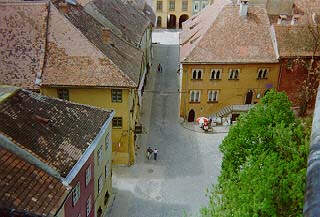
The visit to Sighisoara was one of
the highlights of my trips. This Romanian town has a very well
preserved medieval citadel which contains in its main square the house
where Vlad Tepes was born (on photo "Casa Vlad Dracul" is the
yellow/brown house on the left of the courtyard). On the outside of the
house is a plaque which reads (in translation): "In this house lived
between the years 1431 -1435 the ruler of Wallachia Vlad Dracul son of
Mircea the Old". The upstairs portion of the house where there was once
the Receiving Room has been converted into a restaurant. There is a
fascinating thing on the upper corner of one of the walls - a part of a
mural that was recently discovered under another layer of covering. It
shows a figure that experts believe is Vlad Dracul. If this is so, it
is the only known visual representation of him. Eventually work will be
continued to see how extensive this old mural is. It was also in 1431
that Vlad (the father) was awarded the Order of the Dragon and became
known by the sobriquet "Dracul". At that time he was military governor
of Transylvania but was later to become prince (voivode) of Wallachia,
the position that had formerly been held by his father Mircea.
TIRGOVISTE
When Vlad Dracula first became
Voivode of Wallachia (briefly) in 1448, the capital of the principality
was Tirgoviste. About 80 km northwest of Bucharest, Tirgoviste is of
great interest to the Dracula enthusiast because of the remains of
Vlad's palace that can still be seen there. It was at Tirgoviste,
during Vlad's longest period in power (from 1456-62) that he committed
many of the atrocities attributed to him in various historical
documents. [One needs to bear in mind that many of these accounts were
written by his enemies and therefore could have been exaggerated.]
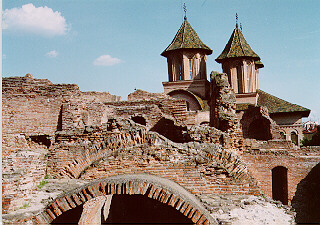
The best known episode associated
with the palace at Tirgoviste is the seizing of the "boyars" at the
Easter celebrations. Vlad blamed the nobles of Tirgoviste for the death
of his older brother (Mircea had been buried alive by some of the
citizens several years earlier). He invited all the nobles and their
family to an Easter feast, after which he seized them, impaled the old
and the very young, and put the rest into forced labor building his
fortified castle on the Arges River (more about that castle later).
There is a tower among the ruins at the Tirgoviste palace, on which is
the lookout ledge where Vlad Tepes would watch the impalements in the
courtyard below. Other events associated with that palace include the
nailing of caps to the heads of the two ambassadors, the incident of
the extra ducat, and the golden cup - and numerous others.
Quite near the palace ruins, on
the side of a main street in Tirgoviste, is a bust of Vlad Tepes, an
indication of his important place in history. And it was at Tirgoviste
that the former Communist dictator of Romania (Ceaucescu) and his wife
were executed in December of 1989.
BRAN
CASTLE
Bran Castle is the most famous
"Dracula" site having no significant connection with Dracula! I am
including it because so many visitors to Romania have been (and still
are) under the impression that it is "Dracula's Castle". Located near
the city of Brasov, in the southern range of the Carpathians, it is an
impressive medieval castle. But there is only a minimal connection
between this castle and Vlad Tepes (he may have stayed there briefly on
one of his excursions into Transylvania or may even have been held
there briefly by Matthias Corvinus, but it certainly was not his castle
and he never lived there. As for any connection with the Count Dracula
of Stoker's novel, there is absolutely none.
As for the reasons for this
confusion, I suspect there are two: Bran Castle is a complete edifice
that LOOKS like it should be Dracula's Castle (while the real one, as
we shall see, is a ruin); and Bran is near the main tourist trade -
near Poiana Brasov etc (while the real one is in a much more
inaccessible location). At the World Dracula Congress in 1995, the
curator at Bran offered another explanation. The castle was for decades
presented to western tourists who came to Romania insisting on seeing
"Dracula's Castle". This is what they were presented with. The
misconception lingers to this day and is reinforced by the fact that
the merchandise stalls at the foot of Bran are the best source of
Dracula souvenirs in Romania! Of course, Bran attracts hundreds of
visitors a day (it is on all of the standard tour routes) while the
actual castle/fortress of Vlad (at Poenari), off the beaten track,
draws only a few.
POENARI:
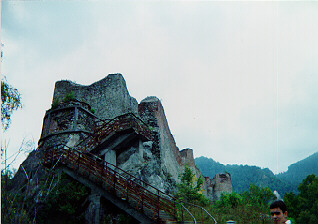
If there is an edifice that can be
labelled Vlad Dracula's castle, it is the ruins of Poenari. Actually,
this is a fortress ("cetate" in Romanian) rather than a castle, located
at the entrance to the gorge of the Arges River, north of the town of
Curtea de Arges. As you leave Curtea de Arges (itself an interesting
town with fortifications dating back to the 13th century and Basarab
1), you drive over a secondary road through several little villages,
proceeding up the Arges valley towards the base of the Carpathian
range.The road reaches the base of a group of high, heavily wooded
mountains and there on the rocky top of one of them is Cetatea Poenari
- Dracula's Castle. Even from the road below it is a forbidding sight.
What strikes one is its inaccessibility, high on a mountain top and the
entrance to the gorges of the river (the river, by the way, has been
diverted by a hydro-electric project). Poenari was the castle
fortification that Vlad Tepes forced the nobles of Tirgoviste to build.
The nobles were forced to walk the distance from Tirgoviste to the
Arges (quite considerable by road - probably about 60 km overland) and
then drag the material up that mountain to build the castle.
 To get to the top, one has to walk up almost
1500 steps. But the effort is certainly worth it. As you approach the
magnificent ruin (last 50 steps or so) the scene is totally Gothic.
There is the outline of the castle perched on the top of this rock,
seeming to grow out of the very mountain itself. It covers the full
space at the top, has a sheer drop on three sides, and is barely
accessible by a small bridge near the top of the steps. To get to the top, one has to walk up almost
1500 steps. But the effort is certainly worth it. As you approach the
magnificent ruin (last 50 steps or so) the scene is totally Gothic.
There is the outline of the castle perched on the top of this rock,
seeming to grow out of the very mountain itself. It covers the full
space at the top, has a sheer drop on three sides, and is barely
accessible by a small bridge near the top of the steps.
I have returned to this site three
times, as it is one of my favorite places in Romania: not only because
of the sense of history but the magnificent scenery. One particular
view (looking northwest) is spectacular - just the way you might
picture the landscape around Dracula's Castle in Stoker's novel (though
Stoker knew nothing about this place).
This is the
route that, according to local legend, Vlad took in order to escape
into Transylvania from the Turks in 1462. He was assisted in his
efforts by the villagers of nearby Arefu, where many narratives about
Vlad still live in their oral culture.
 Then there is the southern
wall of the castle - a sheer drop! Then there is the southern
wall of the castle - a sheer drop!

This is where,
according to another local legend, Vlad Tepes' first wife flung
herself, committing suicide rather than being taken captive by the
advancing Turks. This castle is where Vlad would go for refuge in the
face of advancing enemies. And from its towers he had a commanding view
of anyone approaching from any direction. It was practically
impenetrable.
SNAGOV
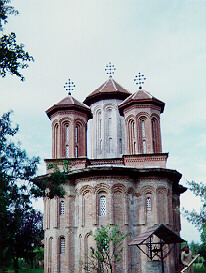 Lake
Snagov is located just about 20 miles or so north of Bucharest. The
monastery is on an island in the middle of the lake, accessible only by
boat. The Snagov Monastery is traditionally believed to be the burial
place of Vlad Tepes., though there is not complete agreement about
whether this is the case. Lake
Snagov is located just about 20 miles or so north of Bucharest. The
monastery is on an island in the middle of the lake, accessible only by
boat. The Snagov Monastery is traditionally believed to be the burial
place of Vlad Tepes., though there is not complete agreement about
whether this is the case.
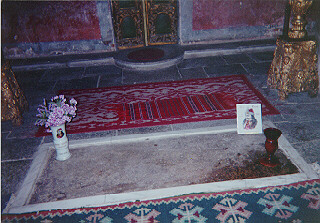 According to some
historical accounts, his headless body was taken to the monastery and
buried in front of the altar. The spot is clearly marked with a small
portrait of Vlad, and a vase of fresh flowers - another indication of
his stature as a national hero. This was the site that was excavated in
1931 by Rosetti & Florescu, only to find that there was no
coffin, no body, only a few animal bones! Where was (is) Vlad Tepes?
There are two main theories. One is that his body was later moved to a
place near the entrance of the chapel where a body was actually found,
though positive identification was difficult. This body has since
disappeared. Another theory is that he is in the original place (near
the altar) but further down. There is talk of another excavation. But
for now, the whereabouts of Vlad's remains is a mystery. According to some
historical accounts, his headless body was taken to the monastery and
buried in front of the altar. The spot is clearly marked with a small
portrait of Vlad, and a vase of fresh flowers - another indication of
his stature as a national hero. This was the site that was excavated in
1931 by Rosetti & Florescu, only to find that there was no
coffin, no body, only a few animal bones! Where was (is) Vlad Tepes?
There are two main theories. One is that his body was later moved to a
place near the entrance of the chapel where a body was actually found,
though positive identification was difficult. This body has since
disappeared. Another theory is that he is in the original place (near
the altar) but further down. There is talk of another excavation. But
for now, the whereabouts of Vlad's remains is a mystery.
CONCLUSION
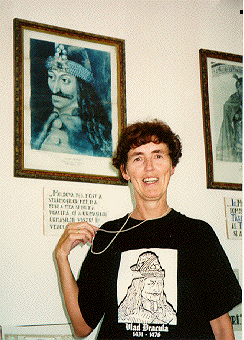 A portrait of Vlad Tepes hangs on the wall of
a classroom at the village school in Arefu. This is a reminder of the
fact that he is considered to be one of the heroes of the country's
history. While many in the West may find this strange, we need to keep
in mind that Vlad defended his small principality of Wallachia from the
mighty armies of the Sultan of Turkey (Vlad was, in essence, a David
fighting a Goliath) at a time when the Ottoman Empire was a powerful
force in Eastern Europe and the Balkans. A portrait of Vlad Tepes hangs on the wall of
a classroom at the village school in Arefu. This is a reminder of the
fact that he is considered to be one of the heroes of the country's
history. While many in the West may find this strange, we need to keep
in mind that Vlad defended his small principality of Wallachia from the
mighty armies of the Sultan of Turkey (Vlad was, in essence, a David
fighting a Goliath) at a time when the Ottoman Empire was a powerful
force in Eastern Europe and the Balkans.
|





 To get to the top, one has to walk up almost
1500 steps. But the effort is certainly worth it. As you approach the
magnificent ruin (last 50 steps or so) the scene is totally Gothic.
There is the outline of the castle perched on the top of this rock,
seeming to grow out of the very mountain itself. It covers the full
space at the top, has a sheer drop on three sides, and is barely
accessible by a small bridge near the top of the steps.
To get to the top, one has to walk up almost
1500 steps. But the effort is certainly worth it. As you approach the
magnificent ruin (last 50 steps or so) the scene is totally Gothic.
There is the outline of the castle perched on the top of this rock,
seeming to grow out of the very mountain itself. It covers the full
space at the top, has a sheer drop on three sides, and is barely
accessible by a small bridge near the top of the steps. Then there is the southern
wall of the castle - a sheer drop!
Then there is the southern
wall of the castle - a sheer drop!

 According to some
historical accounts, his headless body was taken to the monastery and
buried in front of the altar. The spot is clearly marked with a small
portrait of Vlad, and a vase of fresh flowers - another indication of
his stature as a national hero. This was the site that was excavated in
1931 by Rosetti & Florescu, only to find that there was no
coffin, no body, only a few animal bones! Where was (is) Vlad Tepes?
There are two main theories. One is that his body was later moved to a
place near the entrance of the chapel where a body was actually found,
though positive identification was difficult. This body has since
disappeared. Another theory is that he is in the original place (near
the altar) but further down. There is talk of another excavation. But
for now, the whereabouts of Vlad's remains is a mystery.
According to some
historical accounts, his headless body was taken to the monastery and
buried in front of the altar. The spot is clearly marked with a small
portrait of Vlad, and a vase of fresh flowers - another indication of
his stature as a national hero. This was the site that was excavated in
1931 by Rosetti & Florescu, only to find that there was no
coffin, no body, only a few animal bones! Where was (is) Vlad Tepes?
There are two main theories. One is that his body was later moved to a
place near the entrance of the chapel where a body was actually found,
though positive identification was difficult. This body has since
disappeared. Another theory is that he is in the original place (near
the altar) but further down. There is talk of another excavation. But
for now, the whereabouts of Vlad's remains is a mystery. 
